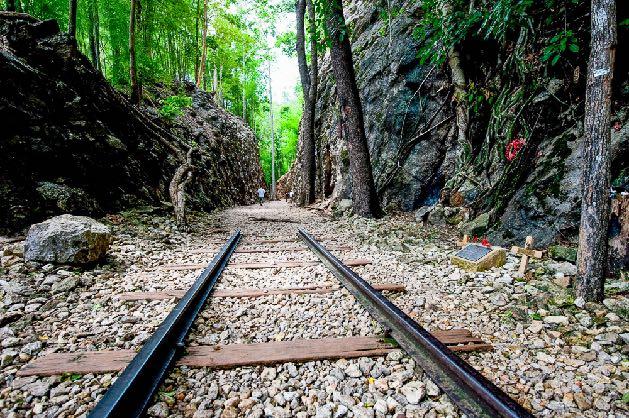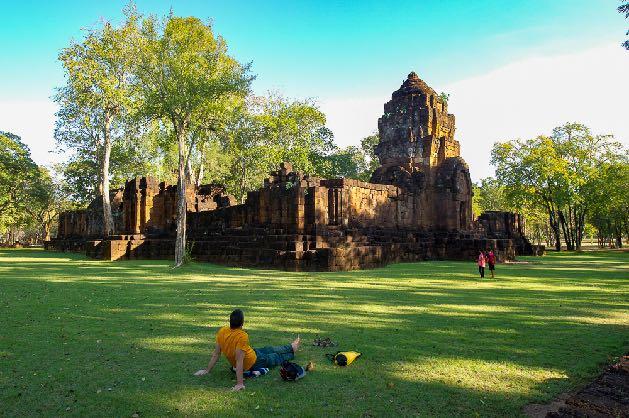
7 minute read
Road Tripping—Kanchanaburi, Thailand
Thailand is ideal for road tripping, thanks to excellent highway systems. With 1,200 miles from north to south and 2,000 miles of coast, road trip opportunities abound when exploring the ‘Land of Smiles’ lush countryside and beautiful shorelines.
One of my favourite road trips is Kanchanaburi City and Province just two hours west of Bangkok. ‘The Bridge Over the River Kwai’ book and movie introduced international audiences to this region. Both dramatized the construction of the Thai-Burma (Death) Railway during the Second World War.
Advertisement
This war history is reason enough to visit. Though look deeper into this enormous province for waterfalls, caves, lakes, hot springs, river rafting, jungle trekking, camping, canoeing, birdwatching, mountain biking, ancient Khmer ruins, impressive Buddhist temples, and much more. Kanchanaburi has it in abundance.
Kanchanaburi City
Kanchanaburi city sits at the confluence of the Khwae Noi and Khwae Yai rivers, and its riverside hotels and guesthouses make an ideal base. Note ‘Kwai’ as used in the book and movie titles is the anglicized version of Khwae.
Here are my recommendations within Kanchanaburi and branching out to provincial attractions.
Thai-Burma (Death) Railway
As the Asia Pacific component of WW2 continued, Japanese forces needed a safe and efficient land route from south-east Asia to its militaries in Burma and the Indian Ocean, thus avoiding allied navies. The construction of a 250-mile railway line from Bangkok to Rangoon in Burma (Myanmar) commenced in 1942 using an approximated workforce of over a quartermillion comprising conscripted locals and 140,000 British, Australian, Dutch and American prisoners of war (POW). Due to the enforced extreme working conditions, over 100,000 died in the railway’s construction - mainly of sickness, malnutrition and exhaustion: all buried in unmarked graves along the rail line.
I’d recommend first-time visitors check out the Thailand-Burma Railway Centre in Kanchanaburi city as this museum and research centre details the Death Railway’s construction while providing a sensitive appreciation of how thousands of POWs died.
Once finished, cross the road to the Kanchanaburi War Cemetery which contains the remains of 6982


Photos (top to bottom): Kanchanaburi War Cemetery; Bridge over River Khwae Yai late afternoon; Scenic Rail train crossing bridge over River Khwae Yai



Photos (top to bottom): Prasat Muang Singh Historical Park © Tourism Authority of Thailand; Hellfire Pass Museum © Tourism Authority of Thailand; Konyu Cutting @ Hellfire Pass Museum © Tourism Authority of Thailand Allied POWs. Poignantly, many of the gravestones are simply marked “Known Only To God.” A few miles away, the smaller Chungkai War Cemetery hosts a further 1750 Commonwealth and Dutch POWs resting in eternal peace.

Bridge Over The River Kwai & Scenic Railway
Kanchanaburi city is home to one of Thailand’s most famous, and perhaps most photographed bridges, the POW-built bridge spanning the River Khwae Yai. Time your visit for the Scenic Rail train crossing and use the ‘step off points’ on the bridge to view the train up close.
This Scenic Railway train travels a leisurely 40 miles out from Kanchanaburi through farmlands and villages along a restored section of the original Thailand-Burma line to Nam Tok station before returning. The train’s wooden bench seats and rusty old ceiling fans add to the character, though its open windows make for easy photography as it lumbers along.
A highlight is Saphan Tham Krasae Station where the train slows to a crawl as it crosses the precariouslooking cliff-side Wang Pho (or Death Valley) Viaduct. On one side, the sheer rock wall towers within touching distance, with a vertical drop down to the river and impressive views out the other side of the train. Many visitors alight here to explore Tham Krasae, a small cave while they wait for the return train. Alternately, you can catch (private or public) transport back.
Northwest of Kanchanaburi
Route 323, to Kanchanaburi’s northwest, loosely follows the Khwae Noi River and on to Three Pagodas Pass on the Thai-Burma border. You don’t need to travel that far to take in the stops I recommend.
Prasat Muang Singh Historical Park
Prasat Muang Singh Historical Park marked the western border of the vast Khmer Kingdom back in the 12th to 14th centuries. This restored archaeological site sits in a relaxed setting surrounded by open forest beside the Khwae Noi River. The central temples and surrounding structures are quite distinctive thanks to the rusty-red coloured laterite stones used in construction. A small museum exhibits several artefacts discovered on-site, including Buddha images. Here is ancient Khmer (Cambodian) history in the far west of Thailand and worth an hour or so of your time.
Hellfire Pass
Funded and managed by the Australian government, the Hellfire Pass Memorial Museum provides an opportunity to appreciate why Allied POWs named
During construction of the Death Railway, the workers needed to make numerous rock cuttings to lay track along steep mountain slopes. Konyu Cutting is the largest and, arguably, the most challenging stretch.
Many museum visitors only see the highly interactive and moving displays and associated viewpoint. Those taking the stairs down into the cutting discover a 120yard-long corridor, hewn 56-foot-deep into the rock. As you walk where tracks once laid reaching the end of this first passage, the serenity surrounds you. A sense of reverence you only feel in places of worship overtakes. In remembrance, some visitors leave flags and flowers along the cutting and commemorative plaque found at the end.
Sai Yok National Park
One further stop if time permits is Sai Yok National Park, twelve miles on from Hellfire Pass. The main attractions are Sai Yok Yai and Sai Yok Lek waterfalls, which plummet eight to ten metres into the river.
North of Kanchanaburi
Highway 3199 runs north from Kanchanaburi and east of the Khwae Yai river to Erawan National Park and onto Sri Nakharin Reservoir and surrounding national park.
Erawan National Park
Thirty-three miles from Kanchanaburi, the very popular Erawan National Park sprawls over 550 square miles of the Salop mountains. While bird watchers, orchid hunters and cave enthusiasts could keep busy within the park for weeks, most come specifically for Erawan Waterfall, a multi-tiered set of falls named after the divine three-headed god of the elephants.
The trail, from the start to the top tier is nearly 1 mile, with the first two tiers most easily accessible. Each level has emerald-green pools with swimming permitted. Freshwater minnow shoal in most pools, so sit still in the water and experience a free fish spa as they pick at your dead skin. As one of Thailand’s most popular, it’s impossible to avoid the crowds at Erawan Falls, so I recommend arriving early morning, avoiding weekends and national holidays.
Sri Nakharin National Park
Sri Nakharin Reservoir and national park is a further 28 miles on from Erawan and does make for a 125 mile round trip from Kanchanaburi. A key attraction is Huai Mae Khamin, a seven-tier waterfall flowing down some 1.1 miles of hillside blanketed in bamboo and banyan trees. Said to rival or better Erawan, without the crowds.


Photos (top to bottom): Huai Mae Khamin Waterfall at Sri Nakharin NP © Tourism Authority of Thailand; Erawan Waterfall Tier 1 at Erawan NP © Tourism Authority of Thailand; Earwan Waterfall Tier 3 at Erawan NP ©Michael Cullen; Opposite Page: Elephant Haven © Tourism Authority of Thailand.jpg

Ethical Elephant Encounters
Used in ancient time to carry kings and noble warriors into battle and until the 1980s to help clear forests for logging and other such labour, Asian elephants have long been part of life in this part of the world. Most recently, captured and trained elephants have been used for entertainment and carrying tourists trekking. Attitudes are changing, and Thailand has a growing number of sanctuaries where rescued elephants can now live without chains or saddles and the demands of a working life.

Visitors to these sanctuaries can learn about these gentle giants’ history and welfare. The Kanchanaburi region has two such shelters—Elephant World off Highway 3199 as you head to Erawan, and Elephant Haven off Route 323 just past Prasat Muang Singh Historical Park. Both offer either half-day, day or longer experiences where you assist these pachyderms in their daily life.
I’ve covered some of my Kanchanaburi highlights. With your own transport, there is so much more to see and experience as you road trip around this region.










